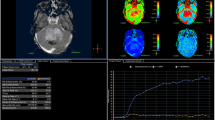Abstract
Purpose
Differential diagnosis between central neurocytoma and ependymoma is very important for making preoperative scheme. We explored the application of diffusion-weighted imaging (DWI) combined with apparent diffusion coefficient (ADC) in differential diagnosis between both.
Methods
The data of preoperative MR plain and contrast-enhanced scan, DWI and ADC values of neoplastic solid parts from 18 cases with central neurocytoma and 19 cases with lateral ventricular ependymoma, were retrospectively analyzed. Mann-Whitney test was used for the comparison of ADC values between central neurocytoma and ependymoma. The application of ADC values in the differential diagnosis between central neurocytoma and ependymoma was evaluated by ROC curve.
Results
The lesions showed hyperintensity-dominant mixed signal intensity on DWI and mean ADC was (0.65 ± 0.13) × 10−3 mm2/s in the 18 cases with central neurocytoma. In the 19 cases with ependymoma, 13 had hyperintensity-dominant mixed signal intensity on DWI and 6 had hypointensity-dominant mixed signal intensity on DWI, and mean ADC was (1.20 ± 0.23) × 10−3 mm2/s. The mean ADC value was significantly higher in the 19 cases with ependymoma than in the 18 cases with central neurocytoma (P < 0.001). The ADC of 0.87 × 10−3 mm2/s might be used as a threshold for differential diagnosis between central neurocytoma and ependymoma with an area under ROC curve of 0.98 ± 0.02 and a 95% confidence interval of 0.95–1.00. Its sensitivity, specificity, and accuracy were 90%, 100%, and 90%, respectively.
Conclusion
There is a certain overlap in MRI imaging features between central neurocytoma and ependymoma. DWI combined with ADC value can improve peoperative diagnostic accuracy.




Similar content being viewed by others
References
Yang I, Ung N, Chung LK, Nagasawa DT, Thill K, Park J, Tenn S (2015) Clinical manifestations of central neurocytoma. Neurosurg Clin N Am 26:5–10
Lejeune JP, Reyns N, Baroncini M, Peltier J, Le Gars D (2011) Ependymomas of the lateral ventricle. A series of 27 cases with review of the literature. Neurochirurgie 57:206–209
Jaiswal S, Vij M, Rajput D, Mehrotra A, Jaiswal AK, Srivastava AK, Behari S, Krishnani N (2011) A clinicopathological, immunohistochemical and neuroradiological study of eight patients with central neurocytoma. J Clin Neurosci 18:334–339
Sun S, Wang J, Zhu M, Beejadhursing R, Gao P, Zhang X, Jiao L, Jiang W, Ke C, Shu K (2018) Clinical, radiological, and histological features and treatment outcomes of supratentorial extraventricular ependymoma: 14 cases from a single center. J Neurosurg 128:1396–1402
Louis DN, Ohgaki H, Wiestler OD, Cavenee WK, Burger PC, Jouvet A, Scheithauer BW, Kleihues P (2007) The 2007 WHO classification of tumours of the central nervous system. Acta Neuropathol 114:97–109
Thompson YY, Ramaswamy V, Diamandis P, Daniels C, Taylor MD (2015) Posterior fossa ependymoma: current insights. Childs Nerv Syst 31:1699–1706
Louis DN, Perry A, Reifenberger G, von Deimling A, Figarella-Branger D, Cavenee WK, Ohgaki H, Wiestler OD, Kleihues P, Ellison DW (2016) The 2016 World Health Organization classification of tumors of the central nervous system: a summary. Acta Neuropathol 131:803–820
Muly S, Liu S, Lee R, Nicolaou S, Rojas R, Khosa F (2018) MRI of intracranial intraventricular lesions. Clin Imaging 52:226–239
Chen H, Zhou R, Liu J, Tang J (2012) Central neurocytoma. J Clin Neurosci 19:849–853
Tlili-Graiess K, Mama N, Arifa N, Kadri K, Hasni I, Krifa H, Mokni M (2014) Diffusion weighted MR imaging and proton MR spectroscopy findings of central neurocytoma with pathological correlation. J Neuroradiol 41:243–250
Delmaire C, Boulanger T, Leroy HA, Tempremant F, Pruvo JP (2011) Imaging of lateral ventricle tumors. Neurochirurgie 57:180–192
Al-Sharydah AM, Al-Arfaj HK, Saleh Al-Muhaish H, Al-Suhaibani SS, Al-Aftan MS, Almedallah DK, Al-Abdulwahhab AH, Al-Hedaithy AA, Al-Jubran SA (2019) Can apparent diffusion coefficient values help distinguish between different types of pediatric brain tumors? Eur J Radiol Open 6:49–55
Soni N, Srindharan K, Kumar S, Bhaisora KS, Kalita J, Mehrotra A, Mishra P (2018) Application of diffusion tensor imaging in brain lesions: a comparative study of neoplastic and non-neoplastic brain lesions. Neurol India 66:1667–1671
Bulakbasi N, Guvenc I, Onguru O, Erdogan E, Tayfun C, Ucoz T (2004) The added value ofthe apparent diffusion coefficient calculation to magneticresonance imaging in the differentiation and grading of malignant braintumors. J Comput Assist Tomogr 28:735–746
Stadnik TW, Chaskis C, Michotte A, Shabana WM, van Rompaey K, Luypaert R, Budinsky L, Jellus V, Osteaux M (2001) Diffusion-weighted MR imaging of intracerebral masses: comparison with conventional MR imaging and histologic findings. AJNR Am J Neuroradiol 22:969–976
Lee EJ, terBrugge K, Mikulis D, Choi DS, Bae JM, Lee SK, Moon SY (2011) Diagnostic value of peritumoral minimum apparent diffusion coefficient for differentiation of glioblastoma multiforme from solitary metastatic lesions. AJR Am J Roentgenol 196:71–76
Wang CY, Cheng JL, Nie YF, Pang BB, Yan J, Song YM (2015) The diagnostic value of ADC combined with DWI in the differentiation of the central neurocytoma and ependymoma. Radiol Practice 30:1011–1015
Chen C , Ren CP , Zhao RC , Ding JW , Cheng JL. Histogram Analysis Parameters ADC for Distinguishing Ventricular Neoplasms of Ependymoma, Choroid Plexus Papilloma, and Central Neurocytoma.Med Sci Monit. 2019 Aug 7;25:5886-5891. https://doi.org/10.12659/MSM.915398
Funding
None.
Author information
Authors and Affiliations
Corresponding author
Ethics declarations
Conflict of interest
The authors declare that they have no conflict of interest.
Ethical approval
This study has been approved by the ethics committee of Second Hospital Affiliated to Lanzhou University.
Informed consent
The patients reported in this study gave written informed consent to participate.
Additional information
Publisher’s note
Springer Nature remains neutral with regard to jurisdictional claims in published maps and institutional affiliations.
Rights and permissions
About this article
Cite this article
Sun, Pf., Ma, L., Ye, Bq. et al. Application of diffusion-weighted imaging combined with apparent diffusion coefficient in differential diagnosis between central neurocytoma and ependymoma. Neuroradiology 62, 439–445 (2020). https://doi.org/10.1007/s00234-019-02342-6
Received:
Accepted:
Published:
Issue Date:
DOI: https://doi.org/10.1007/s00234-019-02342-6




